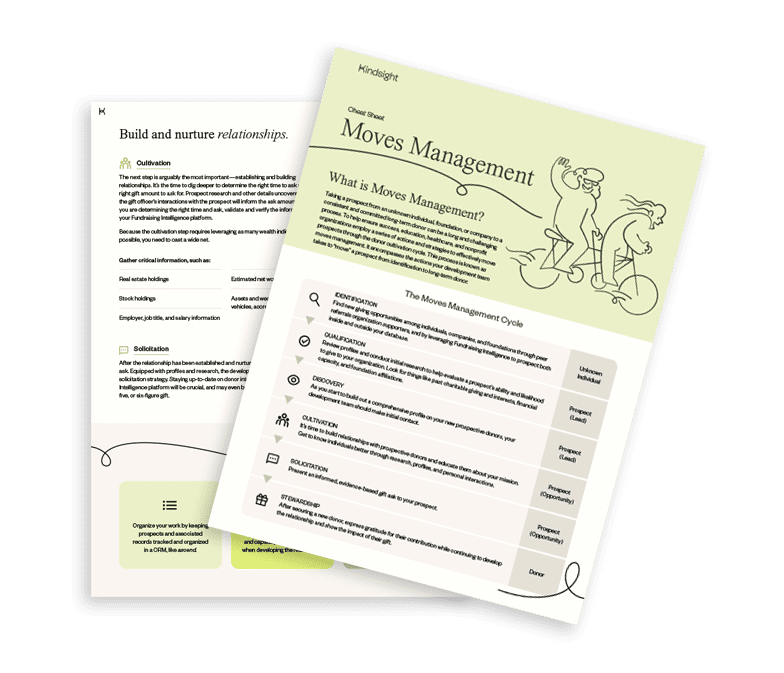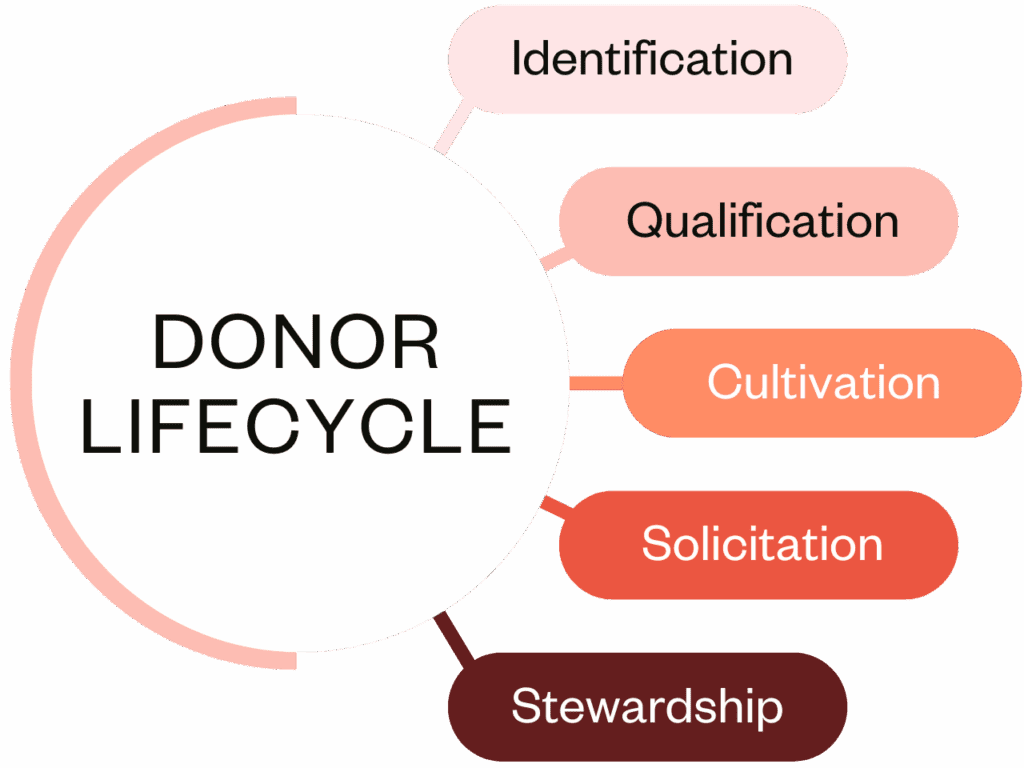
When your organization runs on donations, clearing those checks can start to feel like the only thing that matters. After all, the money you raise helps to keep the lights on. More importantly, it funds your programs, allowing you to fulfill your organizational mission and pursue your goals.
But the real magic of fundraising isn’t in the funds; it’s in the relationships that make giving possible. For any organization to be sustainable, fundraising operations must include far more than simply asking for money. The most successful fundraisers build authentic connections that inspire people to give, to stay engaged, and, in time, to give again. Cultivation and stewardship are two key practices that make those ongoing and return gifts possible.
Cultivation is the intentional development of a donor relationship leading up to a gift, while stewardship is how that relationship is maintained after the gift is received. Many organizations lump these two concepts together or even use the terms interchangeably. Understanding the differences between them—as well as how they work together—is key to growing and retaining your most important donor relationships over time.
In this article, we explore what cultivation and stewardship mean, how the two intersect, and how to do them well for long-term fundraising success.
What is donor cultivation?
Donor cultivation is the intentional process of building and deepening a relationship with a potential donor before they make a gift. Cultivation focuses on connecting with someone who shares the values of your organization, helping them understand your mission and process, and inviting them to become a part of your story.
Cultivation is not about asking for money, although that should be the end goal of all cultivation activity. The goal of cultivation is to help a prospective donor feel connected and engaged with the organization in a way that will inspire them to give later. It’s also a critical opportunity for fundraisers to learn more about a donor’s philanthropic and other interests and passions, to help connect them with the right giving opportunity.
Why cultivation matters
When done well, cultivation transforms prospective donors from check-writers into philanthropic partners who are fully engaged in your mission and want to see your organization succeed. Cultivation ensures that when you ask for a gift, that request feels natural and welcome—not abrupt and not transactional. It also creates an opportunity to ask for (and receive) larger gifts than would otherwise be possible, particularly when the request is aligned to both your organizational need and to the donor’s interests.
Serious about donor cultivation and moves management?
Our guide shows you the strategies and tactics you need to effectively move prospects through the donor cultivation cycle.

Strategies for cultivation
There are many ways that nonprofit organizations can cultivate powerful connections with prospective donors. Here are a few to get you started:
Start with storytelling
Share authentic stories that show your mission in action. This can be done through videos, newsletters, or social media posts, shared digitally or through a one-on-one meeting.
Offer engaging experiences
Invite prospects to events, tours, or volunteer days and let them see your work and your impact firsthand. This experiential engagement builds understanding faster than any brochure can. For high-capacity prospects, these experiences may be offered individually or in small groups, while lower-capacity prospects may be invited to large group events.
Segment your potential donors by capacity
All cultivation activity should start with an end goal, whether that’s securing $50 or $50M. Use your fundraising CRM and prospect research tools to understand the giving potential of your donors, and then craft general cultivation guidelines that work at every level, from targeted email communications to highly personalized individual activities.
Personalize communication
Send tailored updates or notes that reflect a prospective donor’s past involvement or known interests. For some donors, that might mean segmenting your communication and using mail merge to insert key details. For high-potential donors, small gestures like sending a handwritten thank-you note after an event show genuine care.
Ask for input before money
When people feel valued and heard, they feel invested. Invite potential donors to share their perspective or their particular expertise, whether in a survey or by bringing an organizational problem directly to them.
Be patient and consistent.
Building good relationships takes time. It takes an average of 18 months to cultivate and secure a major gift. For principal giving, it’s often much longer, while smaller gifts can happen more quickly. This time isn’t just a waiting period, but should consist of thoughtful, consistent effort to move the relationship forward—effort that should prove more than worthwhile when it’s time to make an ask.
What is donor stewardship?
Donor stewardship begins the moment a gift is made to your organization. Stewardship is the process of thanking, recognizing, and engaging donors after they’ve given to show appreciation, demonstrate the impact of the gift, and build a long-term relationship.
If cultivation is about connection, stewardship is about continuity. It ensures that a donor feels valued and appreciated long after the check clears. Just as importantly, it gives them the confidence to know that their contributions are truly making a difference.
Stewardship looks different at every level of giving, but can include sending a timely thank-you note, recognizing donors publicly, providing updates on the impact of the gift, and, in some cases, offering transparency about how the dollars were spent.
Why stewardship matters
While many organizations don’t give stewardship the time and attention it (and your donors) deserve, it’s vitally important to your fundraising bottom line. Research has shown that improving your donor attrition rates by just 10 percent can lead to a 200 percent increase in value to the organization. Donors who stay with your organization long-term typically increase their own giving, help to engage others, and even make planned gifts, committing their support even beyond their own lifetime.
Stewardship provides donors with the assurance that their generosity matters, that their support is valued, and that their dollars make an impact. Good stewardship efforts build trust and deepen the engagement and commitment of past donors. It also opens the door to future giving, turning gratitude into momentum for your organization.
Strategies for stewardship
If you’re looking to build out your stewardship efforts, here are some proven strategies to consider:
Say thank you promptly and personally
Don’t just send a receipt; send a heartfelt, personalized thank you within 48 hours of receiving a gift. Prioritizing a timely response to a donor’s gift shows them that their contribution matters to your organization.
The art of thank-you letters
Learn best practices for expressing gratitude that enhance donor engagement and retention, and inspire future giving.

Show impact
Send reports, newsletters, or videos that demonstrate the tangible difference that a donor’s gift has made. For major and principal-level donors, those reports may be customized, but even a donor who gives a dollar should be informed of their collective impact.
Recognize your donors in meaningful ways
There are many ways to recognize a donor. Not all donors like to be recognized the same way, and not all gifts warrant the same recognition. Some donors like their names in bright lights, while others prefer to remain anonymous. Always ask your donors how they prefer to be recognized and then act accordingly.
Segment your donors and tailor stewardship to their giving
Major givers, recurring donors, and first-time supporters all require different stewardship approaches. Segment your donors so that you can steward them in a way that reflects their giving, your goals, and the unique relationship you have with each.
Stay in touch
Stewardship should be an ongoing process, not a one-time obligation. Stay in touch with your donors throughout the year, finding unique ways to continue building the relationship that began with cultivation.
Cultivation vs stewardship at a glance
While cultivation and stewardship occur at different stages in your donor relationships, they’re two sides of the same coin. One nurtures potential relationships, while the other strengthens existing ones. The differences come in timing, goal, focus, and intended outcomes, as demonstrated in the chart below.
| Cultivation | Stewardship | |
| Timing | Before a gift | After a gift |
| Goal | Build trust and inspire giving | Build loyalty and inspire repeat giving |
| Focus | Education, connection, and engagement | Gratitude, recognition, and transparency |
| Intended Outcome | Secure a gift | Create future giving opportunities |
How cultivation and stewardship work together in the donor lifecycle
The typical donor lifecycle consists of the five steps leading from the first introduction to the gift and beyond.

- Identification: Identify those who may have an interest in giving to your organization based on current involvement as a volunteer or community member, publicly-known giving to similar organizations, or a personal relationship.
- Qualification: Determine whether the prospect is truly a potential donor at this time, noting whether they have the affinity (a genuine interest in your organization or mission), capacity (the ability to make a gift), and philanthropic inclination (a desire to donate to your organization or at all).
- Cultivation: Establish or deepen the relationship with the prospective donor, with the goal of eventually asking for a gift.
- Solicitation: Request a donation, using your knowledge of the prospect and their giving potential to ask for the right amount at the right time and for the right purpose..
- Stewardship: Maintain the relationship, focusing on acknowledgement, gratitude,and reporting to show the donor that their gift was used well.
These steps may seem linear, but they typically work in a loop; at some point in stewardship, a donor should re-enter identification to determine whether it might be time to start the process over. Donors may also exist in multiple stages at once, such as a donor who is being stewarded for a $5,000 gift while actively being cultivated for a larger solicitation. It’s best to think of the donor lifecycle as a cycle—one that bends and fluctuates with every donor.
When you consider the non-linear nature of the donor lifecycle, it becomes much easier to understand how stewardship and cultivation work together. Stewardship is, in a sense, the start of a new cultivation cycle for most donors. How you manage the gift you’ve already received plays an immensely important role in how you grow the relationship toward another donation—and whether you get that opportunity at all.
Donor journey mapping can also be helpful in visualizing how donors progress through these various stages at your specific organization.
Common pitfalls to avoid in cultivation and stewardship
Here are three common mistakes to watch out for as you cultivate or steward your donors:
- Making an ask too soon. Whether your prospect is in cultivation or in stewardship with the goal of another future solicitation, don’t force them through the donor lifecycle. Every donor moves in their own time; the stronger your relationship is, the better you’ll be able to confidently navigate that timeline.
- Treating stewardship as an afterthought. When your goals are focused on dollars raised, it’s easy to neglect everything that doesn’t directly and immediately lead to a gift. Treat stewardship as a step toward future giving.
- Using a one-size-fits-all approach. Every donor is different, and every gift is different. Use your database to segment donors and ensure that their cultivation and stewardship plans match their potential or past giving.
How technology can help with cultivation and stewardship
Technology is an important part of modern fundraising. It’s especially critical for building more strategic, personalized donor engagement. Nonprofit CRM software allows nonprofits to organize, track, and analyze their cultivation and stewardship efforts across the organization.
Your CRM should help you segment donors by giving area or magnitude, set and manage cultivation and stewardship plans, and store critical data to help you customize your outreach so every donor feels seen and valued. AI-powered tools like Kindsight Intelligence let you easily craft thoughtful messages to your prospects and donors throughout each stage, moving your donors forward with targeted communications.
Conclusion
Cultivation and stewardship are two of the most important elements of a strong, sustainable fundraising program. By intentionally connecting with prospective donors before a gift is made and thoughtfully nurturing those relationships afterward, your organization can transform one-time contributors into lifelong supporters—people who believe enough in your mission to keep it alive over the long haul.
Be the first to read our resources.
The world is changing quickly—and our resources help you stay on top of it all. Sign up to get new insights, success stories, and more, sent right to your inbox.




